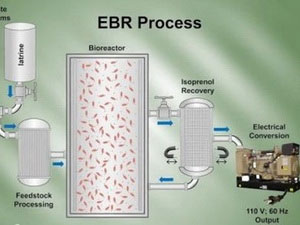Equipment for producing bioenergy from waste
Recently, researchers at Argonne National Laboratory (ANL), of the US Department of Energy, have created a device called a durable bioenergy reactor (EBR) , which can be produced at bioenergy from kitchen waste and toilets.

Images illustrating the process of bioenergy production from EBR equipment.
The above fuel can be supplied directly to engines and generators without any refining process.
According to the researchers, the EBR can produce from 94,6-189.2 liters of biofuel per day from waste or processed cellulose materials.
This technology is based on photosynthetic bacteria through the combination of plant enzymes with an effective lighting system that is abundant in those cells.
Reactions from the combination of enzymes and bacteria will produce fuel molecules, then push them into an environment to isolate and separate from the fermentation solution.
The type of fuel produced at the final stage will not need to be refined and can be used to replace diesel to run engines and generators.
With ease of transport and installation, the EBR is ideal, to serve military and humanitarian activities in remote areas.
It is estimated that an EBR can provide fuel for a generator capable of charging 60 small and medium-sized electric cars each day, with a distance of about 80.4 km / day.
- Production of biofuels thanks to microwaves
- Producing coal from waste
- Producing gasoline directly from scrap
- New step in bioenergy development
- New technology prevents old devices from becoming toxic
- Science is about to generate electricity from garbage that no one dares to recycle
- Producing bricks from ... plastic waste
- Producing bioenergy from diseased plants
- Launching Research Center for Bioenergy application
- Turn hydrogen and carbon dioxide into fuel
- The toilet does not need water
- Russian-made equipment can produce electricity from waste water
 Is the magnetic North Pole shift dangerous to humanity?
Is the magnetic North Pole shift dangerous to humanity? Washington legalizes the recycling of human bodies into fertilizer
Washington legalizes the recycling of human bodies into fertilizer Lightning stone - the mysterious guest
Lightning stone - the mysterious guest Stunned by the mysterious sunset, strange appearance
Stunned by the mysterious sunset, strange appearance